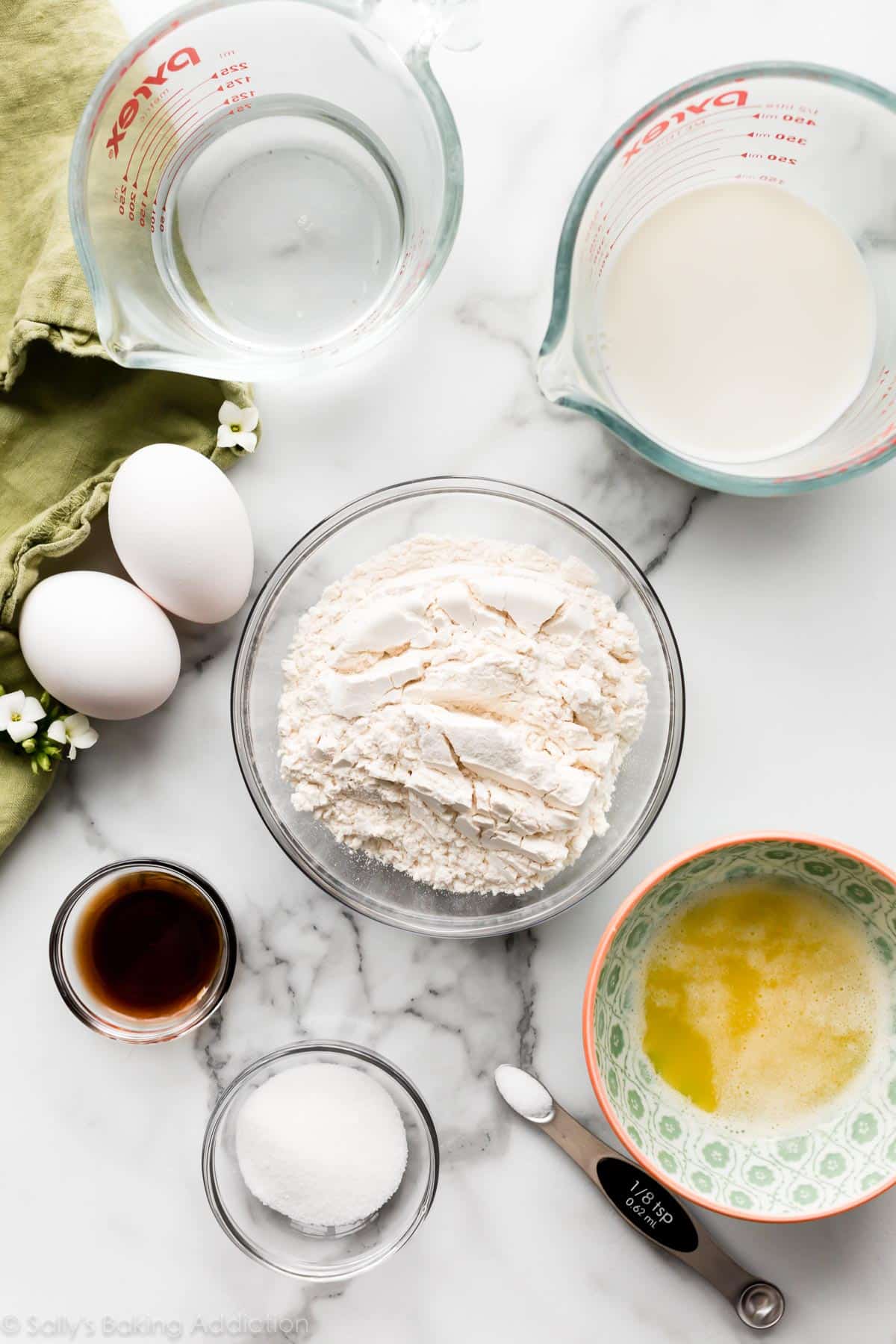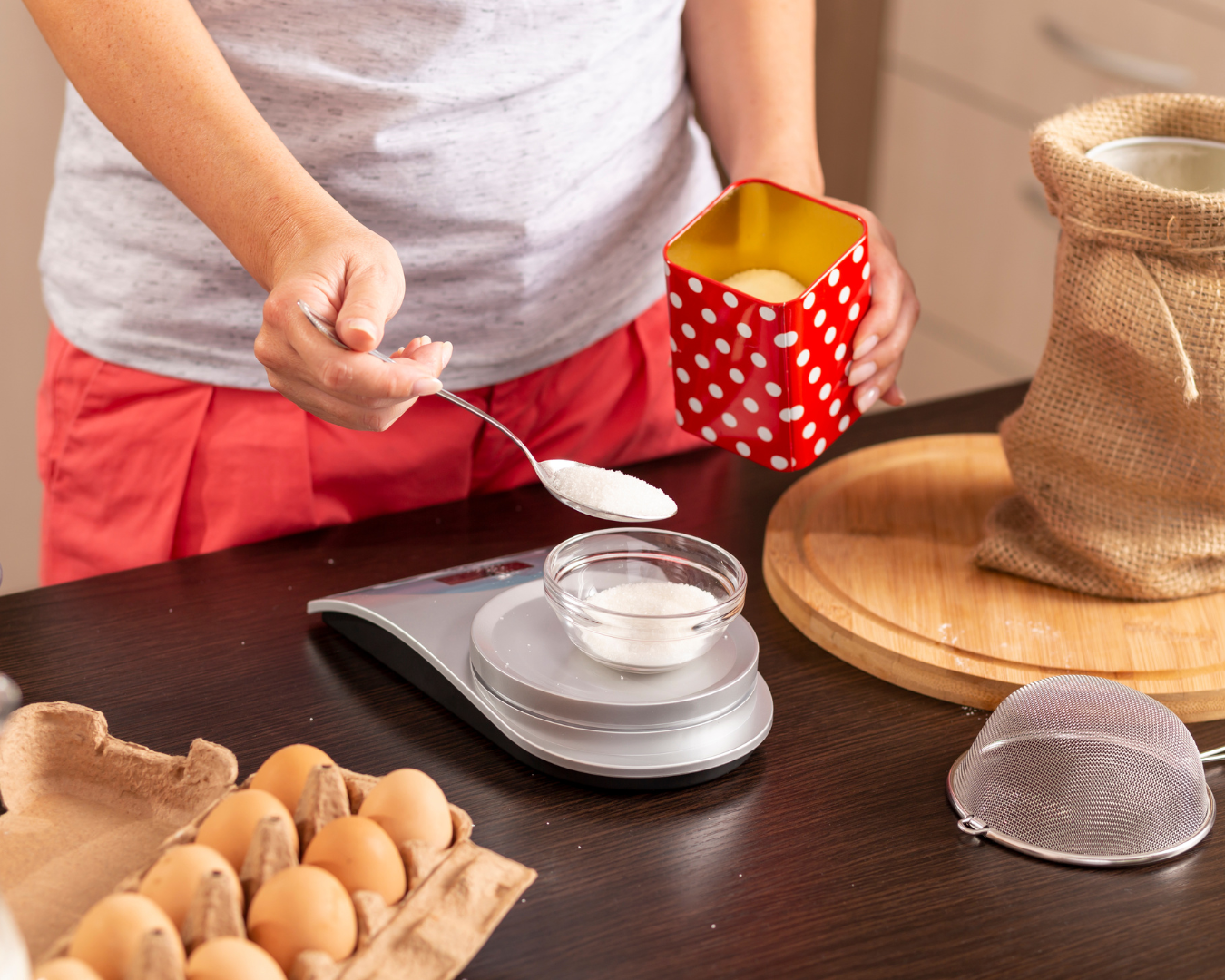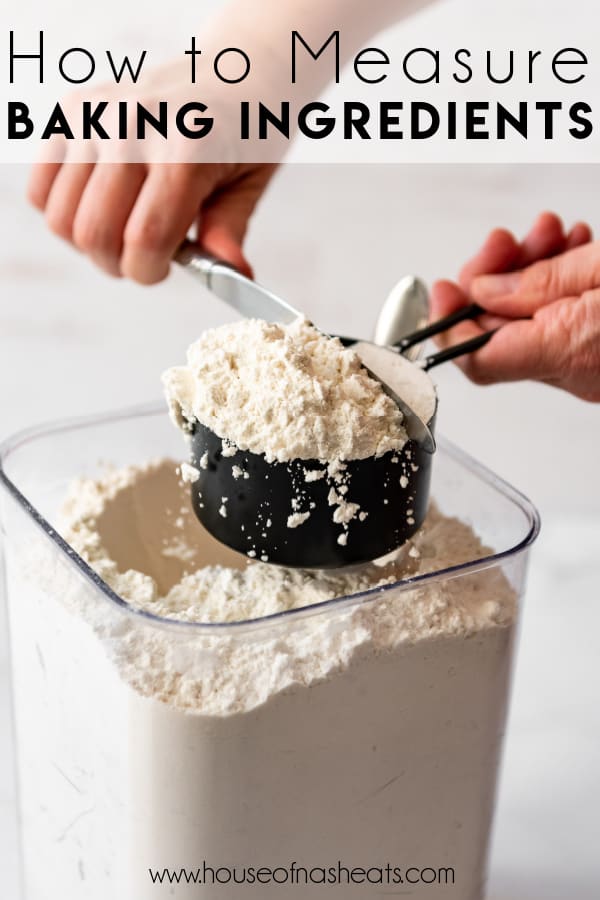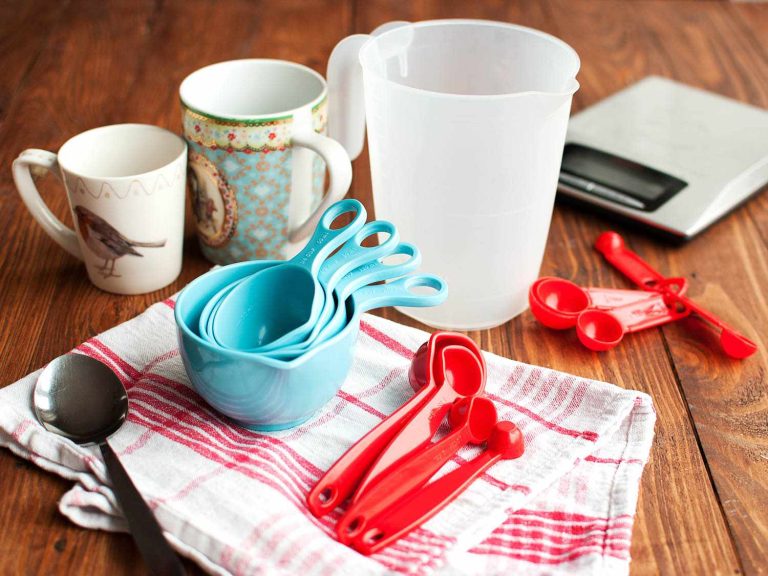Do you love baking but find your cakes and cookies don’t always turn out as expected? You might be surprised to learn that the secret to perfect baking lies in accurately measuring ingredients.
Imagine biting into a cookie that has just the right texture or a cake that rises beautifully every time. This could be your reality! Whether you’re a beginner or have been baking for years, mastering the art of measurement can transform your baking success.
You’ll discover simple techniques and tips to measure ingredients with precision, ensuring your baked goods turn out just right every time. Keep reading to unlock the secrets that professional bakers use to achieve consistent, delicious results. Your kitchen triumphs are just a few steps away!

Credit: sallysbakingaddiction.com
Importance Of Precision In Baking
Baking is a science. Precision is crucial for perfect results. Every ingredient in baking has a role. Even small changes can affect texture and taste. Accurate measurements ensure consistency. This consistency leads to successful baking outcomes. Precision helps achieve desired flavor and texture.
Understanding Baking Ratios
Ratios guide ingredient measurements. Flour, sugar, and fat ratios are key. They determine cake moistness and cookie crunchiness. Knowing ratios helps adjust recipes. It makes improvisation easy and safe.
Proper Measuring Techniques
Use dry and wet measuring tools. Dry cups for flour and sugar. Liquid cups for milk and oil. Spoon flour into cups lightly. Level with a knife for accuracy. Avoid packing flour tightly. It leads to excessive quantity.
Impact Of Ingredient Temperature
Temperature affects ingredient interaction. Cold butter creates flaky pastries. Room temperature butter makes soft cookies. Eggs at room temperature mix better. Warm ingredients lead to smoother batter.
Weight Vs. Volume Measurements
Weight measurements offer precision. Scales provide exact grams and ounces. Volume measurements vary by utensil. Scales eliminate guesswork and error. Weight ensures consistent baking results.
Common Mistakes To Avoid
Packing flour tightly is common. It leads to dense baked goods. Using wrong measuring cups causes errors. Guessing ingredient amounts affects taste. Avoid these mistakes for successful baking.

Credit: cosmoappliances.com
Common Mistakes In Measuring
Measuring ingredients accurately is crucial in baking. A small mistake can ruin a recipe. Many home bakers make common errors that affect their results. Correct measurement ensures consistent and delicious baked goods.
Incorrect Measuring Tools
Using the wrong tools leads to inaccurate measurements. Use dry measuring cups for dry ingredients. Use liquid measuring cups for wet ingredients. Each tool is designed for a specific purpose. Ensure you have the right tools before starting.
Packing The Flour
Packing flour into a cup can add extra weight. This mistake results in dense cakes and cookies. Instead, spoon flour into the cup lightly. Level it off with a knife for accuracy. This method ensures the correct amount of flour every time.
Not Leveling Off
Not leveling off ingredients causes excess amounts. Always level off with a flat edge. This technique ensures precise measurements. It prevents adding too much of any ingredient.
Using Heaping Spoons
Heaping spoons of baking powder or soda can ruin a recipe. Always use level teaspoons or tablespoons. Excess can alter taste and texture. Accurate measurement is key for baking success.
Ignoring Temperature Variations
Temperature affects ingredient weight. Cold butter weighs more than softened. Consider ingredient temperature in your measurements. This attention to detail enhances baking outcomes.
Tools For Accurate Measurement
Accurate measurement is the backbone of successful baking. Without the right tools, even the most promising recipe can fall flat. You might wonder, what are these essential tools that ensure precision every time you bake? Let’s dive into some of the key instruments every baker should have in their kitchen arsenal.
Digital Scales
Digital scales are a game-changer for bakers. They provide precise weight measurements, ensuring consistency. Imagine baking a cake where the flour is just right, not too much or too little.
Using a digital scale, you can measure ingredients like flour, sugar, or butter to the gram. This precision helps avoid the pitfalls of packing or scooping errors. It’s a small investment for big baking success.
Ask yourself, have you ever wondered why professional bakers always get it right? It’s because they weigh their ingredients meticulously. Try it next time you bake and see the difference.
Measuring Cups And Spoons
Measuring cups and spoons are staples in any kitchen. They’re perfect for liquid and dry ingredients. But there’s a catch—using them correctly is vital.
Always level off dry ingredients with a flat edge for accuracy. For liquids, check measurements at eye level. These simple practices can dramatically improve your baking results.
Think about this: have you ever had cookies turn out too salty or a cake too sweet? A tiny measurement mistake can lead to big flavor issues. With careful use of measuring tools, you can avoid these mishaps.
Thermometers
Thermometers aren’t just for checking if meat is cooked. They play a crucial role in baking, too. When working with yeast, the water temperature can make or break your dough.
Use a thermometer to ensure water is between 105°F and 115°F for yeast activation. This range is critical for perfect dough rise. It’s a simple tool that yields impressive results.
Do you always guess if your oven is at the right temperature? A reliable thermometer can help you ensure that your oven is as precise as your measurements. This can make all the difference in achieving that golden crust.
These tools are the secret weapons of baking. They ensure every ingredient is measured with precision, paving the way for delicious success. What’s stopping you from upgrading your baking toolkit today?
Techniques For Measuring Dry Ingredients
Accurate measurement is vital for baking success. Use a spoon to fill the measuring cup with flour. Level it with a knife for precision. This ensures your baked goods turn out perfectly every time.
Accurate measurement of dry ingredients is crucial for successful baking. The right balance can make the difference between a fluffy cake and a dense one. Here are some simple techniques that can help you measure dry ingredients with precision.Using The Spoon And Level Method
This technique is a reliable way to measure flour and similar dry ingredients. First, use a spoon to scoop the flour into your measuring cup. Gently shake the cup to level the flour, then use a flat edge, like a knife, to remove any excess. Avoid packing the flour into the cup as it can lead to using more than needed. This method ensures that the flour is light and fluffy, just like how it’s meant to be in your favorite cake recipe. Have you ever wondered why some cakes turn out heavier than others? This could be the reason.Sifting And Aerating
Sifting can be your secret weapon in the kitchen. It breaks up lumps and aerates the flour, providing a more accurate measurement. Before measuring, sift the flour onto a sheet of parchment paper or a bowl. After sifting, use the spoon and level method to fill your measuring cup. This double technique guarantees precision and improves the texture of your baked goods. Remember the last time your cookies felt heavy? Try sifting next time, and notice the difference. When you take care of measuring your dry ingredients accurately, you set the stage for baking success. Have you tried these techniques? They might just be the game-changer you need for your next baking adventure.Techniques For Measuring Liquid Ingredients
Accurate measurement of liquid ingredients is crucial for successful baking. Mistakes can lead to a recipe disaster. Understanding the right techniques helps achieve perfect results every time. This section explores effective methods for measuring liquid ingredients. It will guide you through simple yet essential processes.
Eye Level Measurement
Eye level measurement ensures precision. Pour the liquid into a clear container. Bend down to check the level at your eye height. This prevents incorrect readings from angles or shadows. Ensure the container is on a flat surface. Keep your eyes parallel to the measurement markings. This technique minimizes errors and ensures accuracy.
Using Measuring Jugs
Measuring jugs are essential tools in baking. Choose a jug with clear measurement markings. Pour the liquid slowly to avoid splashes. Check the measurement at eye level for accuracy. Many jugs have spouts for easy pouring. Hold the jug steady to prevent wobbling. This technique offers precision and convenience in measuring liquids.
Tips For Measuring Sticky Ingredients
Accurate measurement of sticky ingredients like honey or molasses involves using non-stick spray on measuring tools. This helps ensure precise quantities, preventing excess from clinging to surfaces. Use a spatula to scrape the ingredients, leaving no residue behind.
Accurately measuring sticky ingredients is crucial for baking success. These ingredients, like honey and molasses, can be tricky, leading to incorrect quantities if not measured properly. Here are some tips to help you get the right amount without the mess.Greasing Measuring Tools
A simple yet effective way to measure sticky ingredients is by greasing your measuring tools. Use a small amount of oil or non-stick spray on the measuring cup or spoon before adding sticky substances. This creates a slick surface, allowing the sticky ingredient to slide out easily, ensuring you get every last drop. Imagine trying to pour honey from a measuring cup, only to have half of it cling to the sides. A bit of grease can save you from this common frustration. You’ll find your measurements more accurate and your cleanup much easier.Using Warm Water
Warm water can be your best friend when measuring sticky ingredients. Before you measure, fill the measuring cup with warm water, let it sit for a few seconds, then pour it out. The residual warmth helps prevent sticking. This trick works especially well with ingredients like molasses. The heat slightly warms the sticky substance, making it flow more easily. Next time you’re baking, try this method and notice how much simpler it is to get the right amount without the hassle. Have you ever wondered why some recipes seem harder than others? Sometimes, it’s not the recipe but the technique that needs tweaking. Small adjustments like these can transform your baking experience. In your baking adventures, what other clever tricks have you found? Feel free to share your tips in the comments below.Adjusting Measurements For Altitude
Adjusting ingredient measurements for altitude ensures baking success. High altitudes affect baking due to lower air pressure. This can cause ingredients to behave differently, requiring precise adjustments for accurate results.
Baking at high altitude can be a challenge if you don’t adjust your measurements. The air pressure is lower, causing baked goods to rise quickly and then collapse. If you’ve ever baked a cake that turned out more like a pancake, altitude might be the culprit. However, with the right tweaks, you can achieve fluffy pastries and cakes even at higher elevations. Let’s dive into how you can adjust measurements for successful baking at altitude.Understanding Altitude’s Impact On Baking
At higher altitudes, the reduced air pressure affects how ingredients interact. Your baking powder might act like a superhero, causing dough to rise too fast. As a result, your creations might deflate before you know it. This means you need to tweak the amount of leavening agents used. A simple reduction can make all the difference.Adjusting Flour And Liquid Quantities
Flour and liquids play a major role in baking success. At altitude, you’ll often need more flour to provide structure. This helps your cakes and cookies maintain their shape. On the flip side, adding extra liquid can keep your baked goods moist and prevent them from drying out. It’s a balancing act that requires a bit of trial and error.Modifying Sugar And Fat Content
Sugar can be sneaky at high altitudes. It can cause your batter to over-expand and collapse. Consider reducing sugar slightly to keep your baked goods intact. Similarly, fat can be adjusted to enhance texture. If you find your muffins are too crumbly, add a little more butter or oil for a smoother crumb.Personal Experience: Learning From Mistakes
I remember the first time I baked cookies in the mountains. They spread out like pancakes and were far too sweet. I adjusted the sugar and added more flour, and the next batch was perfect. Sometimes, your first attempt may not be great, but each mistake brings you closer to mastering altitude baking.Practical Tips For Successful High-altitude Baking
– Be patient: It might take a few tries to perfect your recipe. – Experiment: Small changes can lead to big improvements. – Keep notes: Document your adjustments for future reference. – Ask questions: How does the altitude affect your favorite recipe? Adjusting measurements for altitude is a skill that can transform your baking. With practice, you can enjoy delicious creations regardless of your elevation.
Credit: houseofnasheats.com
Advanced Techniques For Professional Baking
Baking is a science. Success depends on precise ingredient measurements. Advanced techniques ensure accuracy and consistency. Professional bakers use these methods to craft perfect pastries. Mastering these skills elevates your baking to new heights.
Using Weight Over Volume
Weight measurement is vital in professional baking. Volume measurements can vary greatly. A cup of flour can weigh differently each time. Humidity affects volume measurements too. Using a kitchen scale ensures consistency. Scales provide exact measurements. This leads to better results every bake.
Incorporating Precision Tools
Precision tools make a difference. Digital scales are essential for bakers. They measure ingredients accurately. Even small amounts can impact recipes. Digital scales offer precision up to a gram. Thermometers help with temperature control. Oven and ingredient temperatures matter. Precision tools ensure your bake is perfect.
Frequently Asked Questions
What Is The Most Accurate Way To Measure Ingredients When Baking?
Use a digital kitchen scale for precise ingredient measurements. Weighing ensures accuracy, improving baking results. Measuring cups can be inconsistent. Scales provide exact weight in grams or ounces, enhancing recipe consistency. Accurate measurements prevent baking mishaps, ensuring perfect textures and flavors.
Digital scales are essential for professional and home bakers.
How Do You Calculate Baking Ingredients?
Use a kitchen scale for accurate measurements. Convert cups to grams or ounces. Check ingredient-specific conversions. Adjust recipes based on serving sizes. Ensure precision for consistent results.
How Do You Measure Correct Quantities Of Ingredients?
Use a digital kitchen scale for precise measurements. Utilize measuring cups and spoons for dry and liquid ingredients. Follow recipe instructions carefully to ensure correct quantities. Adjust quantities as needed for taste and texture. Practice helps improve accuracy over time.
What Is The Most Accurate Measurement For Baking A Cake?
Use digital kitchen scales for precise measurements. Measure ingredients in grams for accuracy. Use measuring cups for liquids. Ensure spoon measurements are level for dry ingredients. Accurate measurements ensure better baking results.
Conclusion
Accurate measurement is key to successful baking. It ensures consistent results. Use the right tools like cups and spoons. Always level off ingredients for precision. Measuring liquids? Check at eye level for accuracy. Follow recipes closely to avoid mistakes. Baking scales offer even more precision.
Practice makes perfect. Over time, you’ll become more comfortable. Baking is both science and art. With careful measuring, your treats will taste amazing. Enjoy the process and the delicious results. Happy baking!


